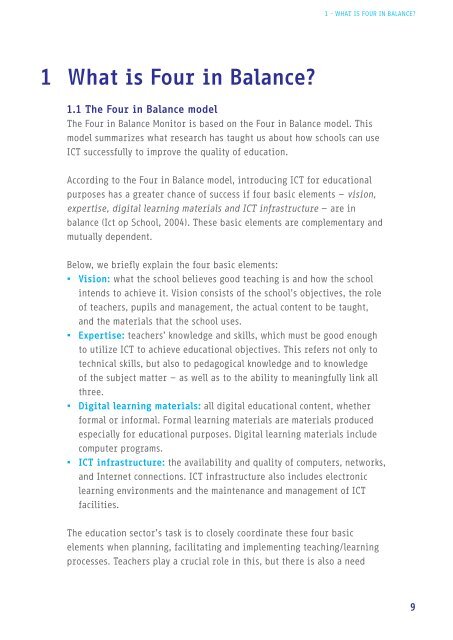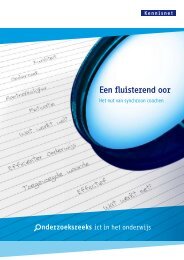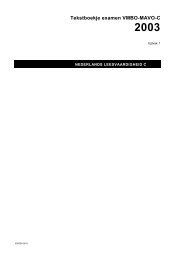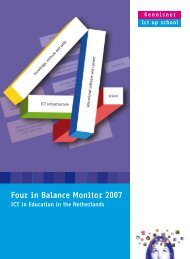Four in Balance Monitor 2011 - downloads.kennisn... - Kennisnet
Four in Balance Monitor 2011 - downloads.kennisn... - Kennisnet
Four in Balance Monitor 2011 - downloads.kennisn... - Kennisnet
Create successful ePaper yourself
Turn your PDF publications into a flip-book with our unique Google optimized e-Paper software.
1<br />
What is <strong>Four</strong> <strong>in</strong> <strong>Balance</strong>?<br />
1 - WhAT IS FoUr IN BALANCE?<br />
1.1 The <strong>Four</strong> <strong>in</strong> <strong>Balance</strong> model<br />
The <strong>Four</strong> <strong>in</strong> <strong>Balance</strong> <strong>Monitor</strong> is based on the <strong>Four</strong> <strong>in</strong> <strong>Balance</strong> model. This<br />
model summarizes what research has taught us about how schools can use<br />
ICT successfully to improve the quality of education.<br />
Accord<strong>in</strong>g to the <strong>Four</strong> <strong>in</strong> <strong>Balance</strong> model, <strong>in</strong>troduc<strong>in</strong>g ICT for educational<br />
purposes has a greater chance of success if four basic elements – vision,<br />
expertise, digital learn<strong>in</strong>g materials and ICT <strong>in</strong>frastructure – are <strong>in</strong><br />
balance (Ict op School, 2004). These basic elements are complementary and<br />
mutually dependent.<br />
Below, we briefly expla<strong>in</strong> the four basic elements:<br />
• Vision: what the school believes good teach<strong>in</strong>g is and how the school<br />
<strong>in</strong>tends to achieve it. Vision consists of the school’s objectives, the role<br />
of teachers, pupils and management, the actual content to be taught,<br />
and the materials that the school uses.<br />
• Expertise: teachers’ knowledge and skills, which must be good enough<br />
to utilize ICT to achieve educational objectives. This refers not only to<br />
technical skills, but also to pedagogical knowledge and to knowledge<br />
of the subject matter – as well as to the ability to mean<strong>in</strong>gfully l<strong>in</strong>k all<br />
three.<br />
• Digital learn<strong>in</strong>g materials: all digital educational content, whether<br />
formal or <strong>in</strong>formal. Formal learn<strong>in</strong>g materials are materials produced<br />
especially for educational purposes. Digital learn<strong>in</strong>g materials <strong>in</strong>clude<br />
computer programs.<br />
• ICT <strong>in</strong>frastructure: the availability and quality of computers, networks,<br />
and Internet connections. ICT <strong>in</strong>frastructure also <strong>in</strong>cludes electronic<br />
learn<strong>in</strong>g environments and the ma<strong>in</strong>tenance and management of ICT<br />
facilities.<br />
The education sector’s task is to closely coord<strong>in</strong>ate these four basic<br />
elements when plann<strong>in</strong>g, facilitat<strong>in</strong>g and implement<strong>in</strong>g teach<strong>in</strong>g/learn<strong>in</strong>g<br />
processes. Teachers play a crucial role <strong>in</strong> this, but there is also a need<br />
9








